Mirabilis jalapa 'Broken Colors'
FOUR O'CLOCKS, MARVEL OF PERU, CLAVILLIA, PRETTY BY NIGHT
syn. Mirabilis lindheimeri
Family: Nyctaginaceae
Pronounced: mee-RAH-bih-lis HAH-lah-pah
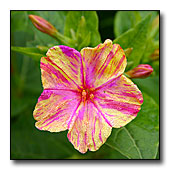
Quick Jumps
Growing Guide
Rainy Side Notes
GROWING GUIDE
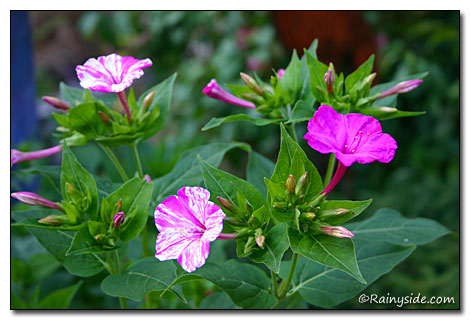
Origin:
Garden.
Plant Group:
Perennial.
Hardiness:
Sunset zones: 4-24, H1, H2.
USDA zones: 8-11.
Heat zones: 12-1.
Mature size:
Height: 36 inches (90 m).
Width: 36 inches (90 cm).
Flowering period:
Midsummer to late summer.
Flowering attributes:
Fragrant, 2-inch long flowers open in late afternoon and continue until morning when the flower closes up and dies. The blossoms are in shades of pink, white, red or yellow.
Leaf attributes:
Up to 4-inch long ovate leaves.
Growth habit:
Clump-forming.
Light:
Full sun.
Soil:
Humus rich, well-drained soil.
Feeding:
Mulch in the fall with a dry mulch. Fertilize monthly, spring through early summer with a complete organic fertilizer.
Propagation Methods:
In early spring sow seed at 55-64°F (13-18°C). | Divide tubers in spring.
Pests and Diseases:
White or brown rust and leaf spot may be a problem. This has not been a problem on my plants.
Rainy Side Notes
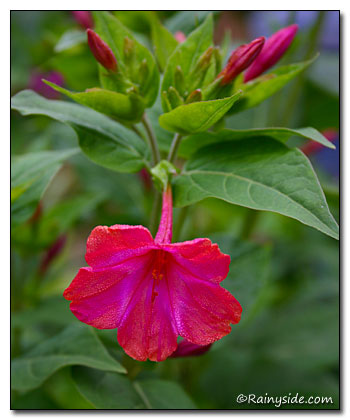
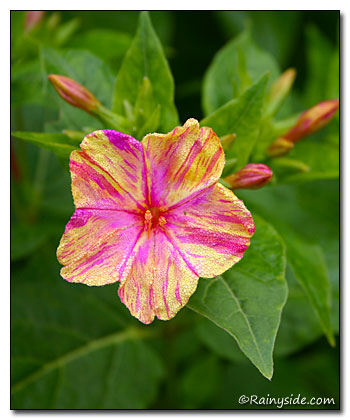
It has been a long working day; plus, you had to fight through commuter traffic to get to work and back. Now that you are home, you climb out of uncomfortable business clothes and throw on the loose-fitting clothes that demand you to let go of the day. After pouring a glass of iced tea, you step into the garden to relax, plopping down into your favorite outdoor chair. As you begin to unwind, you throw your feet up on the ottoman, breathe in a sweet fragrance, and sigh, letting all the stress of the workday release from your body. There in front of you are the lovely four o'clock flowers. It is as if they waited for you to come home and unwind the day. Then, the blossoms open their pretty faces and release their sugar and lemon fragrance into the cool evening air to compliment your iced tea.
Its common name, Miracle of Peru, holds more than just a promise of relaxation. As you unwind in your garden, you can't help but be captivated by the unique characteristics of this plant. Imagine the stir it caused when it was brought back from the Andes Mountains in the New World to Europe. The miracle, they thought, was how this shrubby perennial could have flowers of varying colors on just one plant without the help of grafts or multiple plants in the same planting hole. The excitement of this plant's introduction in the Old World back in the 1540s is akin to how plant collectors get excited about a new genus today.
More Notes Below
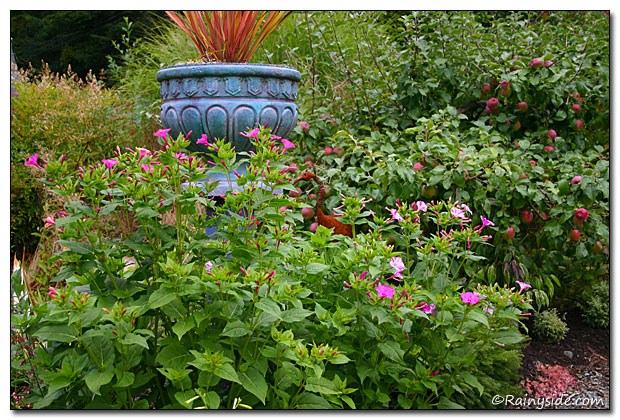
A Victorian horticulturist once said that Pretty-by-night (one of its other common names) and flower names beginning with pretty were "only used by the vulgar." Sounds like this person needed some loose-fitting clothes to help eliminate the "uptightness."
Originally named Admirabilis, Linnaeus changed it to Mirabilis, the Latin word for wonderful. Pharmacists mistakenly believed that the purgative jalap (named after Jalapa, a Mexican town) came from the roots of Mirabilis, so they called the species jalapa. It turned out it was not so; however, the name stuck.
In my garden, they winter over underground and in spring, they grow quickly; by summer, they are three feet tall and fill their space as green bushes. During the day, Mirabilis assumes a quiet position in the garden. However, as evening draws near, the flowers burst open and perfume the night air, turning it into the perfect commuter's flower. With a mirabilis to greet you, who needs a dog? And you don't even have to take it for a walk. This plant has the power to turn any garden into a relaxing, fragrant oasis.
If you live in the colder parts of the Pacific Northwest, you can lift the tubers in the fall (like a dahlia) and store them in a warm, dry place. Plant them out again in spring once the soil warms up. The plants will self-seed, but not obnoxiously. You will want to weed out young seedlings anywhere they are not wanted. Once tubers form, they can be more challenging to dig out. Tubers will flower earlier than seedlings. Excessive winter moisture is detrimental to the tubers, so provide good drainage.
Even though this plant is used medicinally, parts of the plant are poisonous when ingested.
Photographed in author's garden.
A Pacific Northwest Plant of the Week (2013)

Gardening for the Homebrewer: Grow and Process Plants for Making Beer, Wine, Gruit, Cider, Perry, and More
By co-authors Debbie Teashon (Rainy Side Gardeners) and Wendy Tweton
Copyright Notice | Home | Search | Perennials

